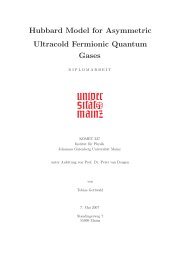5 Hirsch-Fye quantum Monte Carlo method for ... - komet 337
5 Hirsch-Fye quantum Monte Carlo method for ... - komet 337
5 Hirsch-Fye quantum Monte Carlo method for ... - komet 337
Create successful ePaper yourself
Turn your PDF publications into a flip-book with our unique Google optimized e-Paper software.
5.8 Nils Blümer<br />
The ratio of the determinants of new and old matrix can be easily determined using the inverse<br />
of the old matrix: 9<br />
R σm := det(Mσ ′ )<br />
det(Mσ) = det� 1+∆ σm (Mσ) −1�<br />
= 1+2∆τ λσsm(Mσ) −1<br />
mm<br />
The inversion ofMis also elementary, one obtains:<br />
(Mσ ′ ) −1 = (Mσ) −1 + 1<br />
R σm (Mσ) −1 ∆ σm (Mσ) −1<br />
This reduces the ef<strong>for</strong>t <strong>for</strong> the recalculation of a term of (16) after a spin flip toO(Λ 2 ).<br />
Only <strong>for</strong> Λ � 30 can all terms be summed up exactly. Computations at larger Λ are made<br />
possible by <strong>Monte</strong> <strong>Carlo</strong> importance sampling which reduces the number of terms that have to<br />
be calculated explicitly from2 Λ to orderO(Λ).<br />
2.2 <strong>Monte</strong> <strong>Carlo</strong> importance sampling<br />
<strong>Monte</strong> <strong>Carlo</strong> (MC) procedures in general are stochastic <strong>method</strong>s <strong>for</strong> estimating large sums (or<br />
high-dimensional integrals) by picking out a comparatively small number of terms (or evaluating<br />
the integrand only <strong>for</strong> a relatively small number of points). Let us assume we want to<br />
compute the averageX := 1<br />
M<br />
and x some observable with the (true) variance vx = 1<br />
M<br />
(21)<br />
(22)<br />
�M l=1xl, wherel is an index (e.g., an Ising configurationl ≡ {s})<br />
� M<br />
l=1 (xl − X) 2 . In a simple MC ap-<br />
proach, one may select a subset of N ≪ M indices independently with a uni<strong>for</strong>m random<br />
distributionP(lj) = const. (<strong>for</strong>1 ≤ j ≤ N),<br />
XMC = 1<br />
N<br />
N�<br />
j=1<br />
xlj<br />
∆XMC := 〈(XMC −X) 2 〉 = vx<br />
N ≈<br />
1<br />
N(N −1)<br />
N�<br />
j=1<br />
(23)<br />
(xlj −XMC) 2 . (24)<br />
Here, the averages are taken over all realizations of the random experiment (each consisting of<br />
a selection of N indices). In the limit of N → ∞, the distribution of XMC becomes Gaussian<br />
according to the central limit theorem. Only in this limit is the estimate of vx from the QMC<br />
data reliable. An application <strong>for</strong> a continuous set is illustrated in Fig. 3.<br />
Smaller errors and faster convergence to a Gaussian distribution <strong>for</strong> the estimate may be obtained<br />
by importance sampling. Here, the functionxl is split up,<br />
xl = plol; pl ≥ 0;<br />
M�<br />
pl = c, (25)<br />
9 Since ∆ σm has only one non-zero element, it is clear that only the row m of ∆ σm (Mσ) −1 will contain<br />
non-zero elements. The determinant of1+∆ σm (Mσ) −1 is then equal to the product of its diagonal elements.<br />
l=1













